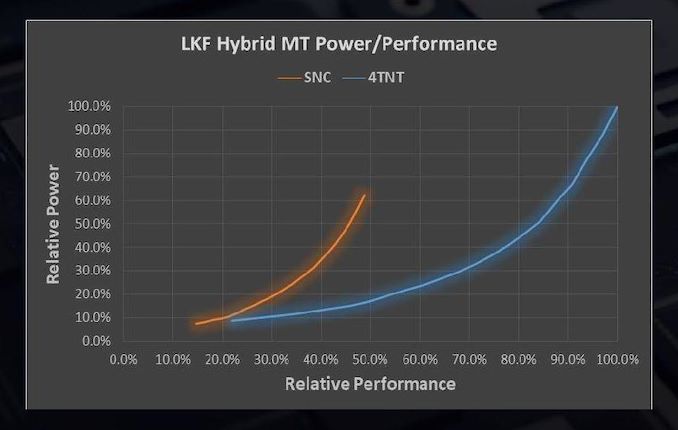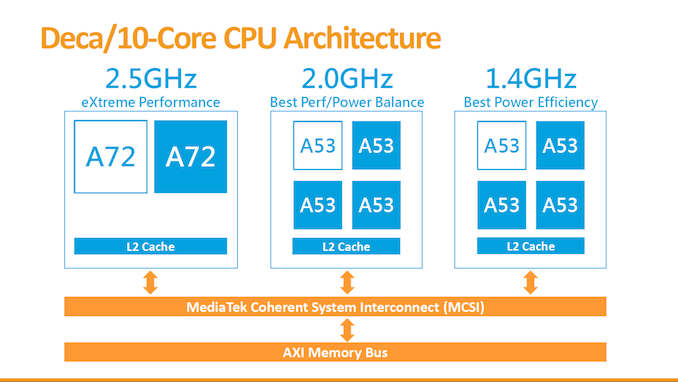The Intel Lakefield Deep Dive: Everything To Know About the First x86 Hybrid CPU
by Dr. Ian Cutress on July 2, 2020 9:00 AM ESTHow To Treat a 1+4 Hybrid CPU
At the top of the article, I explained that the reason for using two different types of processor core, one big on performance and the other big on efficiency, was that users could get the best of both worlds depending on if a workload could be run efficiently in the background, or needed the high performance for a user experience interaction. You may have caught onto the fact that I also stated that because Intel is using a 1+4 design, it actually makes more sense for multi-threaded workloads to run on the four Atom cores.
Using a similar power/performance graphs, the effect of having a 1+4 design is quite substantial. On the left is the single core power/performance graphs, but on the right is when we compare 1 Sunny Cove to all 4 Tremont cores working together.
Where the previous graph considered a 1+1 design, which is more relevant in those user experience scenarios listed above, on the right is the 1+4 design for when the user demands a heavier workload that might not be latency critical. Because there are four Atom cores, the blue line multiplies by four in both directions.
Now obviously the real world scenario is somewhere between the two, as it is possible to use only one, two, or three of the smaller cores at any given time. The CPU and the OS is expected to know this, so it can govern when workloads that can be split across multiple cores end up on either the big core or the small core.
In this graph from Intel, we have three distinct modes on which threads can operate.
- ‘Sunny Cove/SNC’ is for responsiveness and user experience threads,
- ‘Tremont/TNT Foreground’, for user related tasks that require multiple threads that the user is waiting on.
- ‘Tremont/TNT Background’, for non-user related tasks run in efficiency mode
Even though the example here is web browsing, it might be best to consider something a bit beefier, like video encoding.
If we run video encoding, because it is a user related task that requires multiple threads, it will run on the four Tremont cores (TNT FG). Anything that Windows wants to do alongside that gets scheduled as TNT BG. If we then open up the start menu, because that is a responsiveness task, that gets scheduled on the SNC core.
Is 1+4 the Correct Configuration?
Intel here has implemented a 1+4 core design, however in the smartphone space, things are seen a little differently. The most popular configuration, by far, is a 4+4 design, simply because a lot of smartphone code is written to take advantage of multiple foreground or multiple background threads. There are a number of cost-down designs that reduce die area and power by going for a 2+4 implementation. Everyone seems adamant that 4 is a good number for the smaller cores, partly because they are small and cheap to add, but because Arm’s quad-core implementation is a base unit for its IP.
The smartphone space in recent quarters has also evolved from a two tier system of cores. In some of the more leading edge designs, we now have three types of core: a big, a middle, and a small. Because of the tendency to stay with eight core designs, we now get 1+3+4 or 2+2+4 designs, powered by complex schedulers that manage where to put the threads for the best user experience, the best battery life, or somewhere in the middle. Mediatek has been famously dabbling in 10 core designs, going for a 2+4+4 approach.
One thing missing from all of these implementations is an SoC with one big core and four small cores. Smartphone vendors don’t seem to be interested in 1+4 silicon, and yet Intel has decided on it for Lakefield. This is borne out of decisions made on both sides.
From the smartphone perspective, when hybrid designs came about, the big cores just weren’t powerful enough on their own. In order to offer something more than simply basic, at least two cores were needed, but because of how Arm architected the big and little designs, it almost became standard to look into 4+4 implementations of big and small cores. It was only until this configuration was popularized over a couple of years, and Arm big cores got more powerful, that chip designs started looking at 2+4, or 1+3+4 designs.
On Intel’s side of the fence, the biggest problem it has is the size of the Sunny Cove core. By comparison, it’s really, really big. Because the graphics core is the same as Ice Lake and reuses its design, there simply isn’t enough room within the 82 mm2 compute die to add another core. Not only that, but there is a question of power. Sunny Cove wasn’t built for sub-1W operation, even in the Tremont design. We see big smartphone silicon pulling 4-5W when all eight cores are active – there is no way, based on our understanding of Intel’s designs, that we could see four (or even two) Sunny Cove cores being in the optimal performance per watt range while being that low. Intel’s Lakefield graphics, with 64 EUs, is running at only 500 MHz – a lot lower than the Ice Lake designs. Even if Intel moved that down to a 32 EU design to make space for another Sunny Cove core, I reckon that it would eat the power budget for breakfast and then some.
Intel has made the 1+4 design to act as a 0+4 design that sometimes has access to a higher performance mode. Whereas smartphone chips are designed for all eight cores to power on for sustained periods, Lakefield is built only for 0+4 sustained workloads. And that might ultimately be its downfall. This leads onto a deep discussion about Lakefield’s performance, and what we should expect from it.














221 Comments
View All Comments
Drkrieger01 - Friday, July 3, 2020 - link
I'm not one to criticize, but this comment section is a dumpster fire.First of all, this is a FIRST GENERATION PRODUCT that hasn't even/barely made it to market.
Secondly, no one has really gotten to do a deep dive on performance of said product.
Thirdly, this processor package can be used from low end laptops, to tablets, and possibly it other mobile devices.
Fourth - who the hell cares about AVX? Do you people realize just how little AVX-512 is actually used in day-to-day usage scenarios that this CPU would be designed for? (mobile)
How about we wait to see what this product actually does for the technology market before we write it off as 'Intel Trash'.
/drops mic
Wilco1 - Friday, July 3, 2020 - link
What hasn't helped is that both Lakefield and Tremont have been hyped up for some time, so expectations were high. Some sites even claim that Tremont is a Cortex-A77 class core purely based on it having 2x3 decoders... That is setting things up for disappointment and failure."Wait for the next generation, it'll be great" has been used on every Atom, but it never lived up to its promise.
Deicidium369 - Sunday, July 5, 2020 - link
"Wait for the next generation, it'll be great" has been used on every AMD product, but it never lived up to its promise."Wilco1 - Sunday, July 5, 2020 - link
Without a doubt AMD has a much better track record than Intel - where are the 10nm desktops and servers? And Lakefield getting 60% of performance of the 18 month old 8cx is embarassing...lmcd - Sunday, July 5, 2020 - link
Track record is more than the last calendar year in a single market segment. You're kidding yourself if the company that brought Bulldozer, Piledriver, Steamroller, and Excavator to market promising that this was the one that fixed the architecture suddenly gets a pass on everything.Korguz - Monday, July 6, 2020 - link
and yet, it seems intel gets a pass when they make mistakes, or screw up. go figure.Spunjji - Monday, July 6, 2020 - link
Do you want to produce a similar list for the Pentium 4, Itanium, and Atom product ranges, or would that require a little too much intellectual honesty?Both companies have extended periods of bad products. Only one of them had the excuse of mediocre revenues, and only one of them was punished for their repeated failures with a dramatic loss in market share. Tells you a lot, really.
Spunjji - Monday, July 6, 2020 - link
Weird - pretty sure Athlon 64 was a rout, the first Athlon X2 was a rout, and Ryzen 3000 was a rout... You post some of the most asinine crap in this comment section when you're bagging on AMD, which is a real shame, because the rest of the time you seem to make a fair bit of sense.abufrejoval - Friday, July 3, 2020 - link
The entire article is about explaining what can already be inferred from the information we have at hand.Chips are engineering and physics, very little magic and a great degree of predictability.
None of the elements here are first generation, only their combination is a bit new. Ice Lake can be measured, you can benchmark a single core at 5 Watts with ThrottleStop and pinning the benchmark to a single core in any IceLake system. Atoms are well known and we can be sure that when Intel claims 23% improvement at the same power, it won't be 230%.
You can predict it's going to be much more expensive to make than a normal Atom, and you can measure that a single Core CPU below 5 Watts doesn't have a lot of horse power, while multiple cores on this design leave no Wattage for the big one.
This chip will be very expensive to make, so it won't sell at Atom prices. All the engineering is about making small enough to compete with ARM designs, yet capable of competing at 5Watts.
Yes, Ian could still be wrong here and there, but there isn't a lot of room to err.
The rest of us agree, that this chip will fail to make Intel rich and customers happy.
If we should be all wrong, remind us and we'll show proper contrition and learn.
But we bet on what we extrapolate from what we can know and measure, that's our duty as engineers.
lmcd - Sunday, July 5, 2020 - link
Tremont is absolutely new and the thermal characteristics of the package and layout also determine a lot.